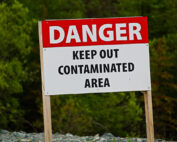Overview of the Claim
On June 14, 2023, Plaintiff Edward C. Moffat filed a legal complaint in Edward C. Moffat v 3M Company et al., suing multiple defendants, including major chemical companies like 3M, DuPont, and Chemours, among others.
The plaintiff alleges personal injury due to exposure to toxic chemicals known as per- and polyfluoroalkyl substances (PFAS) from aqueous film-forming foams (AFFF) during his service in the United States Navy.
This article summarizes the key points and legal claims made in the lawsuit.
Background of the Case
Parties Involved
Plaintiff
▪ Edward C. Moffat, former US Navy aviation boatswain’s mate
Defendant(s)
▪ 3M Company (f/k/a Minnesota Mining and Manufacturing Company)
▪ AGC Chemicals Americas Inc.
▪ Arkema, Inc.
▪ BASF Corporation (Individually and as Successor-in-Interest to Ciba, Inc.)
▪ Buckeye Fire Equipment Company
▪ Carrier Global Corporation
▪ Chemdesign Products, Inc.
▪ Chemguard, Inc.
▪ Chubb Fire, Ltd.
▪ Clariant Corp. (Individually and as Successor-in-Interest to Sandoz Chemical Corporation)
▪ Corteva, Inc.
▪ DuPont de Nemours Inc. (f/k/a DowDuPont, Inc.)
▪ Dynax Corporation
▪ E.I. DuPont de Nemours and Company (Individually and as Successor-in-Interest to DuPont Chemical Solutions Enterprise)
▪ Nation Ford Chemical Company
▪ National Foam, Inc.
▪ The Chemours Company
▪ The Chemours Company FC, LLC
▪ Tyco Fire Products LP
▪ United Technologies Corporation
▪ UTC Fire & Security Americas Corporation, Inc.
Summary of the Allegations
Exposure and Health Impact
Edward C. Moffat served in the U.S. Navy from approximately 1995 to 1998, during which he worked as an aviation boatswain’s mate. This role involved the handling of aircraft fuel and firefighting equipment, which frequently exposed him to PFAS-containing AFFF products.
Moffat was stationed at multiple facilities, including Recruit Training Command Great Lakes in Illinois, Naval Air Station Norfolk in Virginia, Fort Eustis in Virginia, and aboard the USS John C. Stennis (CVN-74). During his service, he was regularly involved in training exercises and emergency responses that used AFFF to extinguish petroleum-based fires.
As a result of his prolonged and repeated exposure to AFFF, Moffat claims to have ingested, inhaled, and absorbed PFAS chemicals through contaminated water and direct contact.
In approximately 2021, Moffat was diagnosed with kidney cancer, a condition he attributes to his exposure to PFAS. The diagnosis led to significant medical treatment, including surgery and ongoing monitoring, which has caused him severe personal injuries, pain, suffering, and emotional distress.
Moffat’s case highlights the severe health impacts that PFAS can have, especially on individuals with prolonged exposure through drinking contaminated water on US military bases.
Defendants’ Knowledge and Actions
The lawsuit asserts that the defendants were aware of the hazardous nature of PFAS but failed to provide adequate warnings or instructions on the safe use and disposal of AFFF products.
The defendants allegedly continued to manufacture, market, and distribute PFAS-containing products despite knowing the risks associated with them.
The complaint highlights that companies like DuPont had knowledge of PFAS toxicity as early as the 1960s and failed to disclose this information to the public or regulatory authorities.
Legal Causes of Action
Strict Products Liability – Defective Design
The plaintiff alleges that the defendants’ AFFF products were defectively designed, making them unreasonably dangerous for their intended use. This claim is based on the argument that safer alternatives were available, and the defendants failed to adopt these alternatives.
Failure to Warn
The lawsuit claims that the defendants did not provide adequate warnings or instructions regarding the dangers of PFAS-containing AFFF products. The plaintiff argues that he and other users were unaware of the risks, leading to harmful exposure.
Negligence
The plaintiff accuses the defendants of negligence for failing to conduct appropriate safety tests, failing to warn users, and failing to recall the dangerous products. The complaint states that the defendants’ negligent actions directly led to the plaintiff’s injuries.
Fraudulent Concealment
The lawsuit also includes claims of fraudulent concealment, alleging that the defendants intentionally withheld critical safety information about PFAS to avoid regulatory scrutiny and liability. This concealment, the plaintiff argues, justifies tolling the statute of limitations.
Analysis and Expectations
Expected Outcome
Given the growing body of evidence linking PFAS exposure to severe health issues and the established knowledge of their toxicity by the manufacturers, the lawsuit is expected to have a substantial impact.
If the court finds the defendants liable, it could lead to significant compensation for the plaintiff and set a precedent for other similar cases. The outcome will depend heavily on the strength of the presented evidence and the court’s interpretation of the defendants’ liability.
Expected Settlement Amounts
Previous settlements in PFAS-related cases provide some context for potential compensation.
For example, in 2017, DuPont and Chemours agreed to a $671 million settlement to resolve 3,550 personal injury claims related to PFOA contamination in Parkersburg, West Virginia.
In 2018, 3M settled a lawsuit with the state of Minnesota for $850 million over PFAS contamination.
Given these precedents, a settlement for Moffat’s case could potentially range from several hundred thousand to millions of dollars, depending on the specifics of the case, the severity of his injuries, and the degree of negligence proven against the defendants.
Timelines
Legal proceedings in such complex cases can be lengthy. The timeline for resolution can range from several months to several years, considering the stages of discovery, potential motions, trial preparations, and possible appeals.
Given the nature of multidistrict litigation (MDL) and the involvement of numerous defendants, each step in the legal process may take considerable time to navigate.
Our legal experts expect that the average case will take 2-3 years to resolve from the date of filing.
Key Takeaways
» Widespread Use of PFAS: PFAS have been extensively used in various industries, particularly in the US military in firefighting foams, due to their effective fire-suppressing properties.
» Health Risks: Exposure to PFAS is linked to severe health issues, including cancer, thyroid disease, and immune system impairment.
» Defendants’ Knowledge: Major chemical companies had knowledge of the risks associated with PFAS but allegedly failed to take appropriate action to protect users and the environment.
» Legal Precedents: This case is part of a broader trend of litigation against manufacturers of PFAS-containing products, seeking accountability for environmental and health damages.
Summary
The lawsuit Edward C. Moffat v. 3M Company et al. underscores the significant health risks posed by PFAS and the alleged negligence of major chemical manufacturers in addressing these risks.
The case highlights the ongoing legal battles faced by these companies and the growing awareness of PFAS-related health issues. As the litigation progresses, it may set important legal precedents for future cases involving PFAS contamination and public health.
By raising awareness about the dangers of PFAS and the legal actions being taken, this case serves as a critical reminder of the importance of corporate responsibility and regulatory oversight in protecting public health and the environment.




